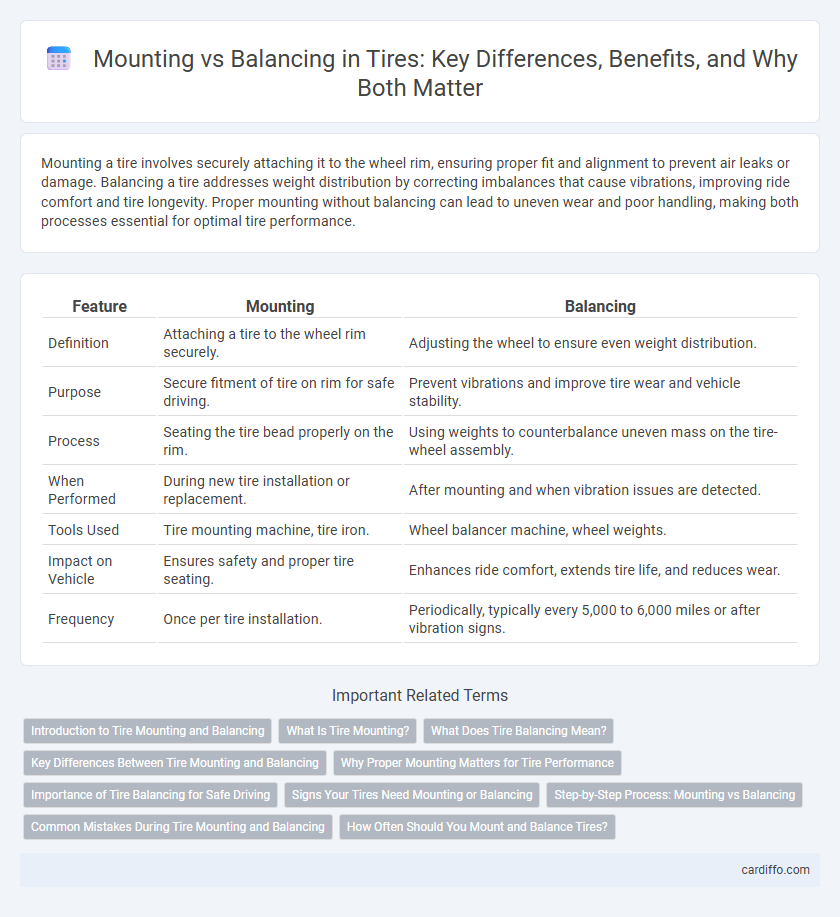Mounting a tire involves securely attaching it to the wheel rim, ensuring proper fit and alignment to prevent air leaks or damage. Balancing a tire addresses weight distribution by correcting imbalances that cause vibrations, improving ride comfort and tire longevity. Proper mounting without balancing can lead to uneven wear and poor handling, making both processes essential for optimal tire performance.
Table of Comparison
| Feature | Mounting | Balancing |
|---|---|---|
| Definition | Attaching a tire to the wheel rim securely. | Adjusting the wheel to ensure even weight distribution. |
| Purpose | Secure fitment of tire on rim for safe driving. | Prevent vibrations and improve tire wear and vehicle stability. |
| Process | Seating the tire bead properly on the rim. | Using weights to counterbalance uneven mass on the tire-wheel assembly. |
| When Performed | During new tire installation or replacement. | After mounting and when vibration issues are detected. |
| Tools Used | Tire mounting machine, tire iron. | Wheel balancer machine, wheel weights. |
| Impact on Vehicle | Ensures safety and proper tire seating. | Enhances ride comfort, extends tire life, and reduces wear. |
| Frequency | Once per tire installation. | Periodically, typically every 5,000 to 6,000 miles or after vibration signs. |
Introduction to Tire Mounting and Balancing
Tire mounting involves securely fitting tires onto wheel rims to ensure proper alignment and safe driving performance. Balancing corrects uneven weight distribution around the tire and rim assembly, reducing vibrations and enhancing vehicle stability. Together, mounting and balancing are critical steps in maintaining tire longevity and optimizing ride quality.
What Is Tire Mounting?
Tire mounting is the process of securely fitting a tire onto a vehicle's wheel rim to ensure proper alignment and safety. It involves placing the tire bead evenly around the rim to create an airtight seal, which is essential for maintaining tire pressure and performance. Correct tire mounting prevents air leaks and prepares the tire for subsequent balancing to ensure smooth vehicle operation.
What Does Tire Balancing Mean?
Tire balancing refers to the process of equalizing the weight distribution of a tire and wheel assembly to ensure smooth rotation and prevent vibrations. During balancing, small weights are attached to the rim to counteract heavy spots caused by manufacturing inconsistencies or tire wear. Proper tire balancing enhances vehicle stability, reduces uneven tire wear, and improves overall driving comfort.
Key Differences Between Tire Mounting and Balancing
Tire mounting involves securely attaching the tire to the wheel rim to ensure proper fit and seal, while tire balancing focuses on evenly distributing the weight around the wheel and tire assembly to prevent vibrations. Mounting requires the use of specialized machines and lubricants to avoid tire damage, whereas balancing utilizes weights placed on the rim to correct imbalances. Proper mounting and balancing are essential for vehicle safety, extended tire life, and optimal driving performance.
Why Proper Mounting Matters for Tire Performance
Proper tire mounting ensures the tire bead seats correctly on the rim, preventing air leaks and maintaining optimal tire pressure for safety and performance. Incorrect mounting can cause uneven tire wear, vibrations, and compromised handling, leading to reduced fuel efficiency and tire lifespan. Balanced mounting distributes the tire's weight evenly around the wheel, but without accurate mounting, even perfectly balanced tires cannot perform at their best.
Importance of Tire Balancing for Safe Driving
Tire balancing is crucial for ensuring even weight distribution around the tire and wheel assembly, preventing vibrations that can lead to uneven tire wear and compromised vehicle control. Proper balancing enhances steering precision, reduces suspension wear, and improves fuel efficiency, significantly contributing to safe driving conditions. Neglecting tire balancing after mounting can result in hazardous driving experiences, including increased stopping distances and loss of vehicle stability.
Signs Your Tires Need Mounting or Balancing
Uneven tire wear, vibration in the steering wheel or floorboard, and audible thumping noises indicate the need for tire balancing. Visible damage such as bulges, cracks, or difficulty in seating the tire properly on the rim signals the necessity for tire mounting. Regular inspection for these signs ensures optimal tire performance, safety, and longevity.
Step-by-Step Process: Mounting vs Balancing
Mounting a tire involves securely fitting the tire onto the wheel rim using a tire mounting machine, ensuring an airtight seal with the bead seated properly. Balancing requires attaching wheel weights to counteract uneven weight distribution, typically performed on a balancing machine that spins the tire to detect imbalances. Both steps are crucial for optimal tire performance, preventing uneven wear and ensuring smooth vehicle operation.
Common Mistakes During Tire Mounting and Balancing
Common mistakes during tire mounting include improper bead seating and inadequate lubrication, which can lead to tire damage and air leaks. Inaccurate balancing often results from failing to remove old wheel weights or using incorrect weight placement, causing vibrations and uneven tire wear. Ensuring precise mounting and balancing procedures extends tire life and improves vehicle safety and performance.
How Often Should You Mount and Balance Tires?
Tire mounting should be performed each time new tires are installed to ensure proper fit and safety. Balancing is recommended every 5,000 to 7,500 miles or whenever you notice vibration, as it prevents uneven tire wear and improves vehicle handling. Regular balancing and mounting enhance tire performance and extend their lifespan significantly.
Mounting vs Balancing Infographic

 cardiffo.com
cardiffo.com